ANCIENT EGYPTIAN ART
For over three thousand years the Egyptians adhered to a prescribed set of rules as to how a work of art in three dimensions should be presented. Egyptian art was highly symbolic and a painting or sculpture was not meant to be a record of as the result of subtle changes, not an altered conception of art or its role in society.
The Tree of Life
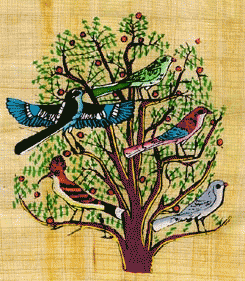
On the Tree Of Life, the birds represent the various stages of human life. Starting in the lower right-hand corner and proceeding counter-clockwise:
In ancient Egypt, the direction east was considered the direction of life, because the sun rose in the east. West was considered the direction of death, of entering the underworld, because the sun set in the west. They believed that during the night, the sun traveled through the underworld to make its way back to the east so it could rise in the east again on the next day.
On the tree of life, note that the birds representing the first four phases of life all face to the east, but the bird representing old age faces to the west, anticipating the approach of death.
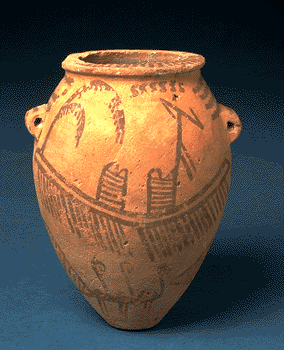
During Neolithic times, known to Egyptologists as the Predynastic period, the dead were buried in a contracted position in shallow pits dug in the sand and were surrounded by grave goods consisting of pots that probably contained food and drink, and personal items such as cosmetic palettes. These objects suggest that there was already a belief in the afterlife. The vessel illustrated here is typical of the Naqada II period, being decorated in red line on a light background. The elaborate motifs relate in part to life on the Nile, and show oared boats, water plants, standards, and birds. Other examples also include wild animals and male or female figures. Such vessels were probably made specifically for burial, rather than for everyday use.
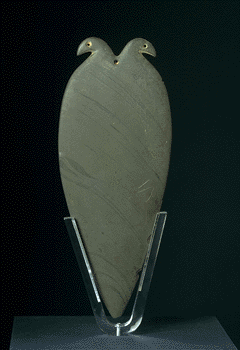
In ancient Egypt, both men and women wore eye makeup, and to manufacture it they ground up mineral pigments on a palette. Such palettes were often put into graves, perhaps to ensure that the deceased had the means to grind eye makeup in the next world.
This palette is made from polished green slate, with two bird heads carved in profile at the top. Three holes have been drilled: a central one may be for hanging, whereas the other two, serving as eyes for the birds, may originally have been inlaid. The birds are possibly falcons, perhaps an early reference to the sky god Horus.
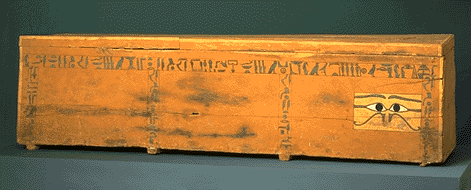
This rectangular coffin was put together from local timber for a priestess of the goddess Hathor called Nebetit. The head end is identified by a pair of stylized eyes, known as wedjat eyes, painted in a panel on the side. The coffin would have been oriented in the tomb with the head end pointing north. This would have enabled the deceased, lying on her side, magically to look out through the wedjat eyes at the sun rising on the eastern horizon – a symbol of rebirth.
The coffin has hieroglyphic inscriptions on the sides, end, and lid. The vertical inscriptions on the sides and ends identify the owner. The long horizontal inscriptions consist of “offering formulae” and ask for offerings for the ka (spirit) of Nebetit. These include beef, fowl, bread, and beer, and also a request for “a good burial in her tomb in the necropolis of the western desert.”
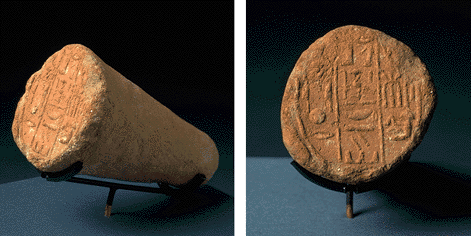
Clay funerary cones originally decorated the mudbrick facades of private tombs at Thebes. They were embedded in rows to form friezes and may have been intended to represent the ends of roof beams. The flattened base of each cone, which was all that remained visible, was stamped with the titles and name of the tomb owner. The cone shown here bears the name of Merymose, the viceroy of Nubia during the reign of Amenhotep III.
The cone bears three columns of hieroglyphic text reading from left to right. The name of Merymose is found in the third column. The first column and the top of the second form the phrase “revered before Osiris.” This is followed by “king’s son of Kush,” the title given to the viceroy of Nubia, a territory to the south of Egypt stretching into modern northern Sudan that was conquered and ruled by the Egyptians during the New Kingdom (1550 – 1070 B.C.).
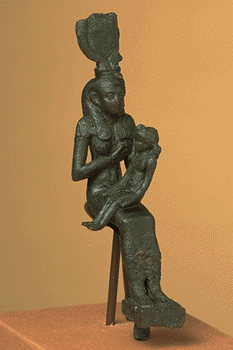
The goddess Isis, sister-consort of Osiris, god of the dead, is represented seated with her son placed at a right angle to her on her lap. She wears a tight-fitting dress and a vulture headdress surmounted by a sun disk enclosed by a pair of cow’s horns, which are now broken. The horns and sun disk were originally associated with the goddess Hathor, but later they were used by Isis too. The child is supported by his mother’s left arm, while her right hand offers her breast for suckling. Horus is given the attributes of a child, being shown naked, with a single lock of hair falling on the right side of his otherwise shaven head, and sucking his forefinger. However, he is also closely associated with the ideal of kingship – the living king being a manifestation of Horus – and so he wears a uraeus (cobra), a symbol of kingship, on his forehead.
Isis was revered as an emblem of motherhood and protector of young children. Possibly due to the shift of political power to the Delta, where in myth Isis raised Horus in secret, the cult of Isis and the child Horus strengthened from the Third Intermediate period onward, and during the Greco-Roman period spread widely through the ancient world. After the Emperor Constantine had made Christianity the official religion of the Roman Empire, the mother-child image formerly attached to Isis and Horus reemerged in representations of the Virgin and Child.
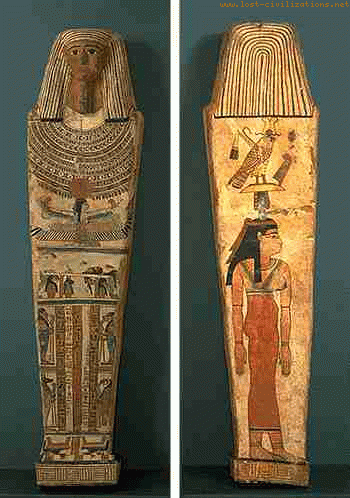
This wooden anthropoid coffin consists of a separate bottom and lid. It is plastered and painted on the outside, but the inside was left undecorated. It is made of irregular pieces of native Egyptian wood, and gaps between planks are filled in with mud. The underside of the base is decorated with a large figure of the goddess of the west, recognizable by the falcon emblem, the hieroglyph for west, that she wears on her head.